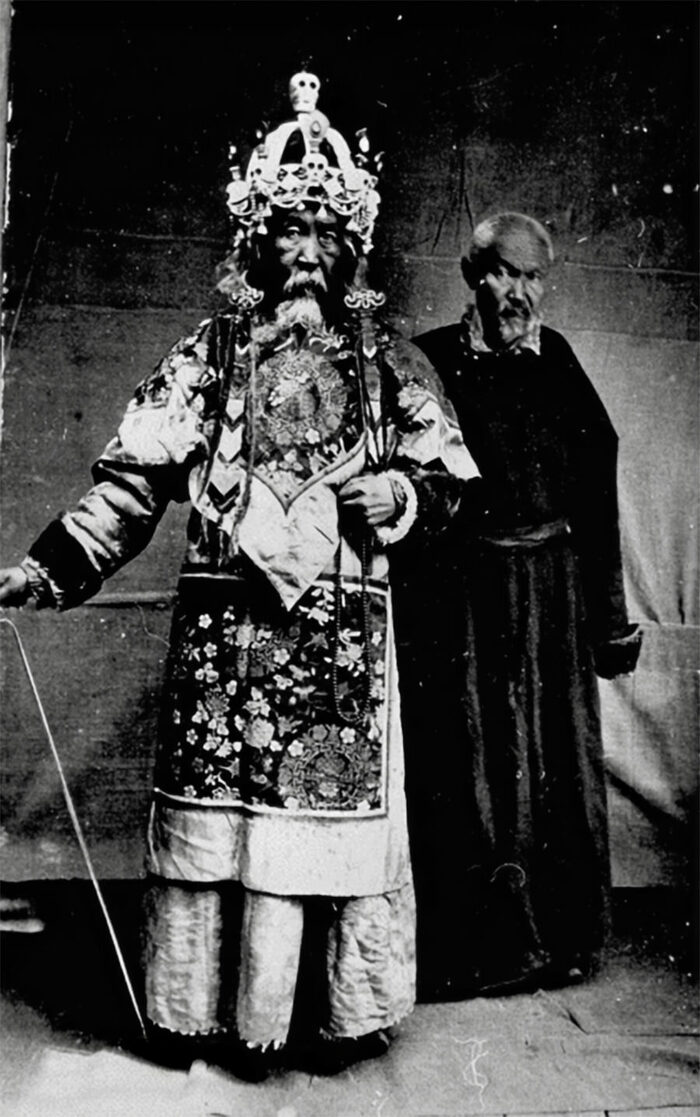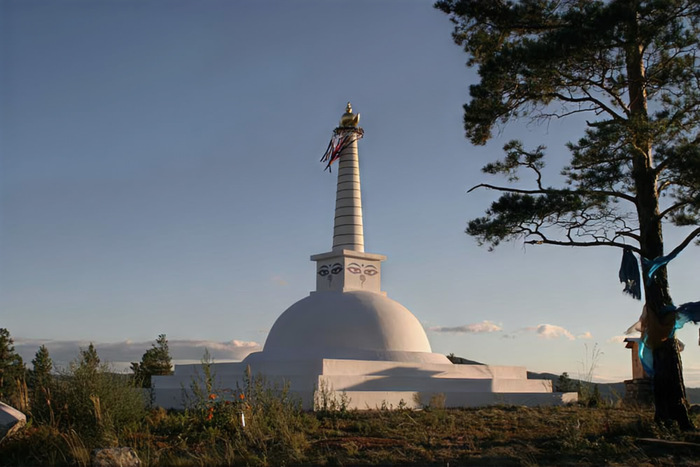Lama Lubsan Sandan Tsydenov
Bidiya Dandarovich Dandaron (1916–1974) is considered the successor of the Balagat movement, a peculiar tradition created by Lama Lubsan Sandan Tsydenov (1850–1922). Tsydenov was a disciple of the same Namnane Lama as was Agvan Dorzhiev (1853–1938) and died at the hands of the same Cheka secret police who had arrested Dorzhiev. However, his path in life was rather different.
Tsydenov was born in Kizhinga, Buryatia. As a child he was sent to the Kizhinga Datsan to study and then from there to the Gusinoozersk Datsan. There, he completed his studies up to the gabju (Tib. bka’-bcu) level, a monastic degree granted after the study of ten scriptural texts.
Together with the Fifth Jayak Gegen (Tib. rGya-yag Rin-po-che), a Tibetan teacher who came to Buryatia from Kumbum Monastery in Amdo, Tibet, he felt the need to renew the practice of the dominant Gelug school in Buryatia. They proposed doing this by placing the emphasis totally on Vajrayana practice, using the best methods that had been developed in the various tantric traditions of Tibetan Buddhism. They wanted to combine the tantras commonly practiced in the Gelug tradition, such as Vajrabhairava, with Hevajra from the Sakya tradition, mahamudra from Kagyu, dzogchen from Nyingma, and chod from the Shijed (Tib. Zhi-byed) Pacifier school.
At the same time, Tsydenov planned to orient spiritual practice around a secular lifestyle rather than a monastic one and around hermitages rather than datsan monasteries. Datsans, in his view, were consumed with samsaric concerns. His plan was in accord with the nineteenth-century Rime (Tib. ris-med) non-sectarian movement in Kham, Tibet, and perhaps could be called “Buryat Rime.”
Whether something lasting came out of his efforts is still hard to evaluate, but the idea seems to have been an interesting one to many people at the time. In bringing it to life, Tsydenov withdrew from the Kizhinga Datsan into the forest to meditate. After spending 23 years in secluded retreat with his closest disciples, he is believed to have achieved the highest realizations.
In 1919, Tsydenov established a Buddhist kingdom in Buryatia and declared himself its Chakravartin Dharma king. The kingdom was divorced from the two factions, the White and the Red, fighting each other in the Russian civil war (1917–1923) and lasted only about a year.

In 1920, Tsydenov ceremonially passed on his teachings to the six-year-old Dandaron as the heir to his throne, considering him to be the reincarnation of the recently deceased Jayak Gegen. The Tibetan search party from Kumbum, however, selected another child as the Sixth Jayak Gegen (rGya-yag Blo-bzang btsan-pa’i rgyal-mtshan) (1916–1990). Tsydenov was repeatedly arrested by both the Whites and the Reds and died in prison in 1922.
Bidiya Dandaron
Young Dandaron studied at a secular school, but being a well-known reincarnation in Buryatia, he experienced the constant attention of the local authorities. In 1933, he went to Leningrad, where he entered the Institute of Aviation Instrument Engineering. He also audited classes at the Oriental Faculty of Leningrad State University, where on the recommendation of Agvan Dorzhiev he studied the Tibetan language under Vostrikov.
In 1937, Vostrikov and Dandaron were arrested. Although Vostrikov was executed, Dandaron was sent to a gulag prison camp, where he was interred until 1943. He was arrested again in 1948 and interred once more until 1956. In a 1956 letter, Dandaron wrote: “I remember and will never forget how twenty years ago, that is on 9.1.37, being very young, I was put in prison. They tortured me, hammered nails under my nails, burned my throat and chest with hard iron. Terrible wounds (traces of torture) are imprinted on my body forever.”
After Dandaron’s release in 1956, he went to Moscow, hoping to get a job at the Institute of Oriental Studies. There, he met with Moscow Orientalists, including his future students Oktiabrina Fedorovna Volkova and Aleksandr Moiseyevich Pyatigorsky (1929–2009), and the next year Yurii Nikolaevich Roerich (George de Roerich, 1902–1960), the son of Nikolai Roerich, upon his return to the USSR from India.
In 1958, Dandaron was fully rehabilitated and returned to Ulan Ude, Burytaia, to find a job in the Tibetology sector at the Institute of Culture, a branch of the Academy of Sciences of the USSR. There, he continued to translate texts and write scholarly works. In 1963, he published a Tibetan-Russian dictionary together with Boris Vladimirovich Semichev and Yuri Mikhailovich Parfionovich (1921–1990).

During these same years, a group of disciples began to gather around him, to whom he passed on his teachings, which he called “Neobuddhism.” Neobuddhism proceeded from the principles of Tsydenov, while trying to present the Dharma in the language of modern science and philosophy, which Dandaron had learned in the gulag camps from professors who were imprisoned there. He also bestowed tantric initiations in a simplified form and conducted rituals.

In 1972, Dandaron was arrested after the complaint of a graduate student who accused him of conducting “sexual rituals.” Several of his students were also arrested with him, but instead of standing trial, they were transferred to mental hospitals. Dandaron died in a gulag camp in 1974.
Orientalists associated with Dandaron lost their jobs or experienced other difficulties. Some, such as Pyatigorsky, emigrated. Small groups of Dandaron’s followers remained, however, in Buryatia, Moscow, Leningrad, Latvia, Lithuania and Estonia up to today.